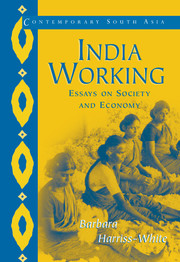Book contents
- Frontmatter
- Contents
- Preface and acknowledgments
- List of maps, figures and tables
- Glossary
- Abbreviations
- 1 Introduction: the character of the Indian economy
- 2 The workforce and its social structures
- 3 Indian development and the intermediate classes
- 4 The local State and the informal economy
- 5 Gender, family businesses and business families
- 6 India's religious pluralism and its implications for the economy
- 7 Caste and corporatist capitalism
- 8 Space and synergy
- 9 How India works
- 10 Postscript: proto-fascist politics and the economy
- Appendix 1 Liberalisation and Hindu fundamentalism
- Appendix 2 Relations between the developmental State and the intermediate classes
- Appendix 3 Roles of religious minorities in the Indian economy
- References
- Index of names
- Index of places
- Index of subjects
3 - Indian development and the intermediate classes
Published online by Cambridge University Press: 06 July 2010
- Frontmatter
- Contents
- Preface and acknowledgments
- List of maps, figures and tables
- Glossary
- Abbreviations
- 1 Introduction: the character of the Indian economy
- 2 The workforce and its social structures
- 3 Indian development and the intermediate classes
- 4 The local State and the informal economy
- 5 Gender, family businesses and business families
- 6 India's religious pluralism and its implications for the economy
- 7 Caste and corporatist capitalism
- 8 Space and synergy
- 9 How India works
- 10 Postscript: proto-fascist politics and the economy
- Appendix 1 Liberalisation and Hindu fundamentalism
- Appendix 2 Relations between the developmental State and the intermediate classes
- Appendix 3 Roles of religious minorities in the Indian economy
- References
- Index of names
- Index of places
- Index of subjects
Summary
Scholars have long sought to explain Indian development through the use of class analysis. Exactly how the dominant class coalition is composed has been heavily contested (like the question of whether agricultural workers and petty producers make a working class, which we discussed in Chapter 2), but few have ever doubted that ‘monopoly capital’, ‘big business’, rich agricultural capitalists and landlords, and the technocratic administrative-cum-political elite have been of crucial importance. An earlier idea that a loose coalition of ‘non-monopoly’ or ‘regional’ capital, or ‘auxiliary classes’ consisting of ‘small landowners, rich and middle peasants, merchants of rural and semi-rural townships, small-scale manufacturers and retailers’, might be the class elements that mattered most for the direction and pace of development has been almost entirely out of court. That idea was first proposed in 1967 by Kalecki in his theory of the ‘intermediate classes’. Then, after some very lively debate about its relevance to India, it was refined and applied rather convincingly to India's conditions of economic stagnation by P.S. Jha, who focused on the specific role of scarcity in this dispersed kind of accumulation. Since the mid-1980s, however, the predisposing conditions for the hold on power of the intermediate classes are thought to have disappeared, and it is evident that liberalisation is not a project of theirs. If our focus is the India of the 88 per cent, however, we need to question the received wisdom about the dominant coalition.
- Type
- Chapter
- Information
- India WorkingEssays on Society and Economy, pp. 43 - 71Publisher: Cambridge University PressPrint publication year: 2002

